Agricultural Land Suitability Assessment Using Satellite Remote Sensing-Derived Soil-Vegetation Indices
Abstract
1. Introduction
2. Materials and Methods
2.1. Study Area
2.2. Image Acquisition
2.3. Digital Image Preprocessing
2.4. Criteria Aggregation for Land Fertility Assessment
2.4.1. Elevation
2.4.2. Slope
2.4.3. Land Surface Temperature (LST)
2.4.4. Soil-Adjusted Vegetation Index (SAVI)
2.4.5. Atmospherically Resistant Vegetation Index (ARVI)
2.4.6. Soil Adjusted and Atmospherically Resistant Vegetation Index (SARVI)
2.4.7. Modified Soil-Adjusted Vegetation Index (MSAVI)
2.4.8. Optimized Soil-Adjusted Vegetation Index (OSAVI)
2.5. Data Aggregation
2.5.1. Pattern Analysis
Moving Average
Multiple Predicted Raster
2.5.2. Land Use/Land Cover
2.6. Land Fertility Assessment
2.6.1. Map Development by Weighted-Linear Combination
2.6.2. Map Development by the Fuzzy Membership Function
2.7. Validation Using Ground Truth Data
2.8. Yield Prediction and Analysis
3. Results
3.1. Land Suitability Analysis
3.2. Yield Estimation
4. Discussion
5. Conclusions
Author Contributions
Funding
Institutional Review Board Statement
Informed Consent Statement
Data Availability Statement
Acknowledgments
Conflicts of Interest
Appendix A
| Ground Points | SAVI | ARVI | SARVI | MASAVI | OSAVI | |||||||||||||||
|---|---|---|---|---|---|---|---|---|---|---|---|---|---|---|---|---|---|---|---|---|
| 2017 | 2018 | 2019 | 2020 | 2017 | 2018 | 2019 | 2020 | 2017 | 2018 | 2019 | 2020 | 2017 | 2018 | 2019 | 2020 | 2017 | 2018 | 2019 | 2020 | |
| 1 | 0.501 | 0.557 | 0.698 | 0.593 | 0.388 | 0.42 | 0.398 | 0.43 | 0.388 | 0.42 | 0.418 | 0.303 | 0.688 | 0.582 | 0.668 | 0.602 | 0.388 | 0.402 | 0.458 | 0.401 |
| 2 | 0.445 | 0.54 | 0.35 | 0.42 | 0.405 | 0.303 | 0.355 | 0.32 | 0.345 | 0.34 | 0.385 | 0.32 | 0.545 | 0.54 | 0.55 | 0.452 | 0.415 | 0.394 | 0.435 | 0.302 |
| 3 | 0.534 | 0.65 | 0.71 | 0.69 | 0.414 | 0.525 | 0.501 | 0.39 | 0.544 | 0.475 | 0.531 | 0.49 | 0.684 | 0.785 | 0.739 | 0.59 | 0.544 | 0.595 | 0.591 | 0.589 |
| 4 | 0.643 | 0.67 | 0.682 | 0.77 | 0.69 | 0.66 | 0.71 | 0.57 | 0.539 | 0.506 | 0.51 | 0.47 | 0.869 | 0.866 | 0.919 | 0.827 | 0.69 | 0.66 | 0.61 | 0.57 |
| 5 | 0.408 | 0.519 | 0.417 | 0.375 | 0.42 | 0.35 | 0.29 | 0.355 | 0.282 | 0.285 | 0.309 | 0.2655 | 0.442 | 0.475 | 0.4729 | 0.3949 | 0.292 | 0.295 | 0.329 | 0.195 |
| 6 | 0.321 | 0.401 | 0.315 | 0.227 | 0.251 | 0.201 | 0.224 | 0.19 | 0.221 | 0.21 | 0.235 | 0.2 | 0.31 | 0.41 | 0.501 | 0.4 | 0.631 | 0.621 | 0.6827 | 0.62 |
| 7 | 0.472 | 0.597 | 0.698 | 0.784 | 0.394 | 0.397 | 0.385 | 0.301 | 0.448 | 0.447 | 0.47 | 0.421 | 0.674 | 0.707 | 0.745 | 0.681 | 0.364 | 0.397 | 0.377 | 0.5501 |
| 8 | 0.595 | 0.671 | 0.772 | 0.689 | 0.681 | 0.661 | 0.5 | 0.59 | 0.4801 | 0.51 | 0.54 | 0.439 | 0.7981 | 0.7981 | 0.829 | 0.739 | 0.681 | 0.61 | 0.5 | 0.79 |
| 9 | 0.799 | 0.797 | 0.779 | 0.769 | 0.669 | 0.577 | 0.67 | 0.539 | 0.479 | 0.508 | 0.529 | 0.449 | 0.799 | 0.896 | 0.99 | 0.859 | 0.379 | 0.386 | 0.49 | 0.289 |
| 10 | 0.479 | 0.621 | 0.631 | 0.303 | 0.33 | 0.366 | 0.431 | 0.31 | 0.33 | 0.32 | 0.31 | 0.303 | 0.415 | 0.436 | 0.4831 | 0.423 | 0.5 | 0.436 | 0.431 | 0.383 |
| 11 | 0.748 | 0.699 | 0.692 | 0.598 | 0.48 | 0.487 | 0.49 | 0.44 | 0.48 | 0.39 | 0.42 | 0.404 | 0.68 | 0.747 | 0.842 | 0.724 | 0.608 | 0.547 | 0.642 | 0.474 |
| 12 | 0.584 | 0.394 | 0.733 | 0.4387 | 0.54 | 0.49 | 0.539 | 0.387 | 0.454 | 0.49 | 0.49 | 0.487 | 0.754 | 0.749 | 0.89 | 0.707 | 0.54 | 0.49 | 0.49 | 0.487 |
| 13 | 0.519 | 0.603 | 0.645 | 0.538 | 0.479 | 0.46 | 0.47 | 0.439 | 0.479 | 0.46 | 0.507 | 0.45 | 0.679 | 0.686 | 0.747 | 0.669 | 0.479 | 0.46 | 0.497 | 0.4069 |
| 14 | 0.688 | 0.789 | 0.667 | 0.582 | 0.38 | 0.439 | 0.41 | 0.312 | 0.408 | 0.415 | 0.478 | 0.37 | 0.718 | 0.739 | 0.741 | 0.702 | 0.358 | 0.309 | 0.371 | 0.252 |
| 15 | 0.484 | 0.411 | 0.583 | 0.292 | 0.312 | 0.301 | 0.391 | 0.282 | 0.22 | 0.291 | 0.23 | 0.212 | 0.44 | 0.31 | 0.623 | 0.52 | 0.24 | 0.31 | 0.33 | 0.182 |
| 16 | 0.419 | 0.372 | 0.44 | 0.36 | 0.35 | 0.312 | 0.34 | 0.30 | 0.29 | 0.22 | 0.254 | 0.22 | 0.39 | 0.32 | 0.24 | 0.5 | 0.39 | 0.432 | 0.424 | 0.405 |
| 17 | 0.45 | 0.562 | 0.685 | 0.541 | 0.43 | 0.502 | 0.425 | 0.341 | 0.35 | 0.373 | 0.385 | 0.31 | 0.655 | 0.642 | 0.635 | 0.5601 | 0.645 | 0.622 | 0.735 | 0.621 |
| 18 | 0.786 | 0.699 | 0.794 | 0.744 | 0.676 | 0.604 | 0.6144 | 0.544 | 0.56 | 0.504 | 0.5144 | 0.4944 | 0.976 | 0.904 | 0.991 | 0.904 | 0.476 | 0.404 | 0.4744 | 0.384 |
| 19 | 0.401 | 0.36 | 0.548 | 0.297 | 0.4 | 0.36 | 0.38 | 0.307 | 0.349 | 0.395 | 0.418 | 0.3279 | 0.74 | 0.736 | 0.858 | 0.77 | 0.34 | 0.426 | 0.434 | 0.377 |
| 20 | 0.487 | 0.601 | 0.751 | 0.475 | 0.387 | 0.397 | 0.441 | 0.25 | 0.487 | 0.37 | 0.431 | 0.375 | 0.787 | 0.797 | 0.794 | 0.695 | 0.587 | 0.607 | 0.641 | 0.595 |
| 21 | 0.788 | 0.692 | 0.789 | 0.774 | 0.696 | 0.652 | 0.66 | 0.501 | 0.531 | 0.502 | 0.53 | 0.464 | 0.761 | 0.862 | 0.85 | 0.824 | 0.661 | 0.692 | 0.695 | 0.584 |
| 22 | 0.787 | 0.793 | 0.8013 | 0.699 | 0.617 | 0.771 | 0.535 | 0.505 | 0.507 | 0.56 | 0.575 | 0.505 | 0.977 | 0.9161 | 0.8535 | 0.905 | 0.337 | 0.301 | 0.335 | 0.29 |
| 23 | 0.4027 | 0.212 | 0.45 | 0.222 | 0.127 | 0.102 | 0.165 | 0.102 | 0.2277 | 0.262 | 0.275 | 0.222 | 0.4377 | 0.432 | 0.425 | 0.382 | 0.477 | 0.462 | 0.5495 | 0.442 |
| 24 | 0.795 | 0.806 | 0.799 | 0.708 | 0.415 | 0.45 | 0.506 | 0.427 | 0.485 | 0.45 | 0.476 | 0.44 | 0.6725 | 0.65 | 0.816 | 0.697 | 0.385 | 0.385 | 0.346 | 0.27 |
| 25 | 0.65 | 0.393 | 0.693 | 0.492 | 0.35 | 0.343 | 0.33 | 0.302 | 0.325 | 0.33 | 0.373 | 0.302 | 0.35 | 0.533 | 0.493 | 0.342 | 0.55 | 0.733 | 0.783 | 0.642 |
| 26 | 0.79 | 0.762 | 0.818 | 0.799 | 0.69 | 0.662 | 0.68 | 0.598 | 0.479 | 0.469 | 0.498 | 0.4998 | 0.979 | 0.9662 | 0.998 | 0.998 | 0.609 | 0.622 | 0.648 | 0.591 |
| 27 | 0.75 | 0.54 | 0.77 | 0.55 | 0.45 | 0.54 | 0.67 | 0.52 | 0.475 | 0.488 | 0.479 | 0.4022 | 0.795 | 0.854 | 0.847 | 0.782 | 0.465 | 0.454 | 0.497 | 0.382 |
| 28 | 0.693 | 0.487 | 0.688 | 0.491 | 0.39 | 0.418 | 0.418 | 0.281 | 0.39 | 0.408 | 0.408 | 0.321 | 0.709 | 0.718 | 0.738 | 0.701 | 0.39 | 0.398 | 0.398 | 0.2971 |
| 29 | 0.512 | 0.605 | 0.586 | 0.36 | 0.491 | 0.425 | 0.56 | 0.35 | 0.32 | 0.35 | 0.36 | 0.395 | 0.45 | 0.52 | 0.603 | 0.495 | 0.52 | 0.55 | 0.66 | 0.5 |
| 30 | 0.701 | 0.503 | 0.629 | 0.635 | 0.51 | 0.523 | 0.619 | 0.485 | 0.497 | 0.453 | 0.509 | 0.4785 | 0.761 | 0.853 | 0.849 | 0.785 | 0.61 | 0.53 | 0.649 | 0.585 |
| 31 | 0.622 | 0.731 | 0.687 | 0.547 | 0.512 | 0.501 | 0.591 | 0.47 | 0.492 | 0.501 | 0.489 | 0.437 | 0.7652 | 0.751 | 0.848 | 0.697 | 0.552 | 0.591 | 0.648 | 0.547 |
| 32 | 0.339 | 0.44 | 0.486 | 0.295 | 0.27 | 0.224 | 0.256 | 0.235 | 0.249 | 0.247 | 0.299 | 0.225 | 0.439 | 0.474 | 0.486 | 0.385 | 0.37 | 0.324 | 0.326 | 0.295 |
| 33 | 0.568 | 0.647 | 0.704 | 0.503 | 0.48 | 0.47 | 0.49 | 0.43 | 0.46 | 0.44 | 0.44 | 0.43 | 0.6 | 0.747 | 0.844 | 0.73 | 0.56 | 0.47 | 0.644 | 0.43 |
| 34 | 0.392 | 0.45 | 0.44 | 0.23 | 0.28 | 0.235 | 0.314 | 0.193 | 0.28 | 0.205 | 0.294 | 0.213 | 0.438 | 0.445 | 0.424 | 0.403 | 0.32 | 0.35 | 0.324 | 0.33 |
| 35 | 0.791 | 0.59 | 0.787 | 0.686 | 0.57 | 0.59 | 0.607 | 0.586 | 0.471 | 0.593 | 0.457 | 0.389 | 0.871 | 0.859 | 0.947 | 0.786 | 0.51 | 0.79 | 0.6747 | 0.586 |
| 36 | 0.598 | 0.697 | 0.778 | 0.609 | 0.38 | 0.403 | 0.458 | 0.395 | 0.488 | 0.447 | 0.549 | 0.435 | 0.688 | 0.582 | 0.668 | 0.602 | 0.68 | 0.694 | 0.6948 | 0.575 |
References
- Kennedy, C.M.; Hawthorne, P.L.; Miteva, D.A.; Baumgarten, L.; Sochi, K.; Matsumoto, M.; Evans, J.S.; Polasky, S.; Hamel, P.; Vieira, E.M.; et al. Optimizing land use decision-making to sustain Brazilian agricultural profits, biodiversity and ecosystem services. Biol. Conserv. 2016, 204, 221–230. [Google Scholar] [CrossRef]
- Pimentel, D.; Burgess, M. Soil Erosion Threatens Food Production. Agriculture 2013, 3, 443–463. [Google Scholar] [CrossRef]
- Jyoti, N.A.; Lal, R.; Das, A.K. Ethnopedology and soil quality of bamboo (Bambusa sp.) based agroforestry system. Sci. Total. Environ. 2015, 521, 372–379. [Google Scholar] [CrossRef]
- Niemeijer, D.; Mazzucato, V. Moving beyond indigenous soil taxonomies: Local theories of soils for sustainable development. Geoderma 2003, 111, 403–424. [Google Scholar] [CrossRef]
- Mazza, A.; Gargiulo, M.; Scarpa, G.; Gaetano, R. Estimating the NDVI from SAR by Convolutional Neural Networks. In Proceedings of the IGARSS 2018 IEEE International Geoscience and Remote Sensing Symposium, Valencia, Spain, 22–27 July 2018; IEEE: New York, NY, USA, 2018; pp. 1954–1957. [Google Scholar]
- Li, Y.; Chen, W.; Zhang, Y.; Tao, C.; Xiao, R.; Tan, Y. Accurate cloud detection in high-resolution remote sensing imagery by weakly supervised deep learning. Remote. Sens. Environ. 2020, 250, 112045. [Google Scholar] [CrossRef]
- Ennouri, K.; Kallel, A. Remote Sensing: An Advanced Technique for Crop Condition Assessment. Math. Probl. Eng. 2019, 2019, 1–8. [Google Scholar] [CrossRef]
- Olivero, J.; Real, R.; Márquez, A.L. Fuzzy Chorotypes as a Conceptual Tool to Improve Insight into Biogeographic Patterns. Syst. Biol. 2011, 60, 645–660. [Google Scholar] [CrossRef]
- Elsheikh, R.; Shariff, A.R.B.M.; Amiri, F.; Ahmad, N.B.; Balasundram, S.K.; Soom, M.A.M. Agriculture Land Suitability Evaluator (ALSE): A decision and planning support tool for tropical and subtropical crops. Comput. Electron. Agric. 2013, 93, 98–110. [Google Scholar] [CrossRef]
- Kazemi, H.; Akinci, H. A land use suitability model for rainfed farming by Multi-criteria Decision-making Analysis (MCDA) and Geographic Information System (GIS). Ecol. Eng. 2018, 116, 1–6. [Google Scholar] [CrossRef]
- Habibie, M.I.; Noguchi, R.; Shusuke, M.; Ahamed, T. Land suitability analysis for maize production in Indonesia using satellite remote sensing and GIS-based multicriteria decision support system. GeoJournal 2019, 1–31. [Google Scholar] [CrossRef]
- Food and Agriculture Organization. A Framework for Land Evaluation; Food and Agriculture Organization: Rome, Italy, 1976. [Google Scholar]
- Tucker, C.J. Red and photographic infrared linear combinations for monitoring vegetation. Remote Sens. Environ. 1979, 8, 127–150. [Google Scholar] [CrossRef]
- Das, A.C.; Noguchi, R.; Ahamed, T. Integrating an Expert System, GIS, and Satellite Remote Sensing to Evaluate Land Suitability for Sustainable Tea Production in Bangladesh. Remote Sens. 2020, 12, 4136. [Google Scholar] [CrossRef]
- Romano, G.; Sasso, P.D.; Liuzzi, G.T.; Gentile, F. Multi-criteria decision analysis for land suitability mapping in a rural area of Southern Italy. Land Use Policy 2015, 48, 131–143. [Google Scholar] [CrossRef]
- Campos, I.; González-Gómez, L.; Villodre, J.; González-Piqueras, J.; Suyker, A.E.; Calera, A. Remote sensing-based crop biomass with water or light-driven crop growth models in wheat commercial fields. Field Crop. Res. 2018, 216, 175–188. [Google Scholar] [CrossRef]
- Essougong, U.P.K.; Slingerland, M.; Mathé, S.; Vanhove, W.; Ngome, P.I.T.; Boudes, P.; Giller, K.E.; Woittiez, L.S.; Leeuwis, C. Farmers’ Perceptions as a Driver of Agricultural Practices: Understanding Soil Fertility Management Practices in Cocoa Agroforestry Systems in Cameroon. Hum. Ecol. 2020, 48, 709–720. [Google Scholar] [CrossRef]
- Bangladesh Bureau of Statistics (BBS). Statistics and Informatics Division (SID) Ministry of Planning: Population and Housing Census 2011; Bangladesh Bureau of Statistics: Dacca, Bangladesh, 2011. [Google Scholar]
- Bangladesh Bureau of Statistics (BBS). Statistical Pocket Book Bangladesh 2016; Ministry of Planning: Dhaka, Bangladesh, 2018. [Google Scholar]
- Bozdağ, A.; Yavuz, F.; Günay, A.S. AHP and GIS based land suitability analysis for Cihanbeyli (Turkey) County. Environ. Earth Sci. 2016, 75, 813. [Google Scholar] [CrossRef]
- Senanayake, S.; Pradhan, B.; Huete, A.; Brennan, J. Assessing Soil Erosion Hazards Using Land-Use Change and Landslide Frequency Ratio Method: A Case Study of Sabaragamuwa Province, Sri Lanka. Remote Sens. 2020, 12, 1483. [Google Scholar] [CrossRef]
- Ashford, S.A.; Sitar, N.; Lysmer, J.; Deng, N. Topographic effects on the seismic response of steep slopes. Bull. Seismol. Soc. Am. 1997, 87, 701–709. [Google Scholar]
- El Kateb, H.; Zhang, H.; Zhang, P.; Mosandl, R. Soil erosion and surface runoff on different vegetation covers and slope gradients: A field experiment in Southern Shaanxi Province, China. Catena 2013, 105, 1–10. [Google Scholar] [CrossRef]
- Zolekar, R.B.; Bhagat, V.S. Multi-criteria land suitability analysis for agriculture in hilly zone: Remote sensing and GIS approach. Comput. Electron. Agric. 2015, 118, 300–321. [Google Scholar] [CrossRef]
- Koulouri, M.; Giourga, C. Land abandonment and slope gradient as key factors of soil erosion in Mediterranean terraced lands. Catena 2007, 69, 274–281. [Google Scholar] [CrossRef]
- Nahusenay, A.; Kibebew, K. Land suitability evaluation in Wadla Delanta Massif of north central highlands of Ethiopia for rainfed crop production. Afr. J. Agric. Res. 2015, 10, 1595–1611. [Google Scholar] [CrossRef]
- Novara, A.; Gristina, L.; Sala, G.; Galati, A.; Crescimanno, M.; Cerdà, A.; Badalamenti, E.; La Mantia, T. Agricultural land abandonment in Mediterranean environment provides ecosystem services via soil carbon sequestration. Sci. Total Environ. 2017, 576, 420–429. [Google Scholar] [CrossRef]
- Basche, A.D.; Archontoulis, S.V.; Kaspar, T.C.; Jaynes, D.B.; Parkin, T.B.; Miguez, F.E. Simulating long-term impacts of cover crops and climate change on crop production and environmental outcomes in the Midwestern United States. Agric. Ecosyst. Environ. 2016, 218, 95–106. [Google Scholar] [CrossRef]
- Jeevalakshmi, D.; Narayana Reddy, S.; Manikiam, B. Land surface temperature retrieval from LANDSAT data using emissivity estimation. Int. J. Appl. Eng. Res. 2017, 12, 9679–9687. Available online: https://www.ripublication.com/ijaer17/ijaerv12n20_57.pdf (accessed on 1 January 2021).
- De Jesus, J.B.; Santana, I.D.M. Estimation of land surface temperature in caatinga area using Landsat 8 data. J. Hyperspectral Remote Sens. 2017, 7, 150–157. Available online: https://periodicos.ufpe.br/revistas/jhrs/article/viewFile/22766/pdf (accessed on 1 January 2021).
- Jiang, Z.; Huete, A.R.; Chen, J.; Chen, Y.; Li, J.; Yan, G.; Zhang, X. Analysis of NDVI and scaled difference vegetation index retrievals of vegetation fraction. Remote Sens. Environ. 2006, 101, 366–378. [Google Scholar] [CrossRef]
- Huete, A. A soil-adjusted vegetation index (SAVI). Remote Sens. Environ. 1988, 25, 295–309. [Google Scholar] [CrossRef]
- Somvanshi, S.S.; Kumari, M. Comparative analysis of different vegetation indices with respect to atmospheric particulate pollution using sentinel data. Appl. Comput. Geosci. 2020, 7, 100032. [Google Scholar] [CrossRef]
- Kaufman, Y.J.; Tanre, D. Atmospherically resistant vegetation index (ARVI) for EOS-MODIS. IEEE Trans. Geosci. Remote Sens. 1992, 30, 261–270. [Google Scholar] [CrossRef]
- Haboudane, D.; Miller, J.R.; Pattey, E.; Zarco-Tejada, P.J.; Strachan, I.B. Hyperspectral vegetation indices and novel algorithms for predicting green LAI of crop canopies: Modeling and validation in the context of precision agriculture. Remote Sens. Environ. 2004, 90, 337–352. [Google Scholar] [CrossRef]
- Kim, M.S.; Daughtry, C.S.T.; Chappelle, E.W.; McMurtrey, J.E.; Walthall, C.L. The Use of High Spectral Resolution Bands for Estimating Absorbed Photosynthetically Active Radiation. In Proceedings of the 6th Symposium on Physical Measurements and Signatures in Remote Sensing, Val D’Isere, France, 17–21 January 1994; pp. 299–306. [Google Scholar]
- Richardson, A.J.; Wiegand, C.L. Distinguishing vegetation from soil background information. Photogramm. Eng. Remote Sens. 1977, 43, 1541–1552. [Google Scholar]
- Mao, Z.-H.; Deng, L.; Duan, F.-Z.; Li, X.-J.; Qiao, D.-Y. Angle effects of vegetation indices and the influence on prediction of SPAD values in soybean and maize. Int. J. Appl. Earth Obs. Geoinf. 2020, 93, 102198. [Google Scholar] [CrossRef]
- Mwinuka, P.R.; Mbilinyi, B.P.; Mbungu, W.B.; Mourice, S.K.; Mahoo, H.; Schmitter, P. The feasibility of hand-held thermal and UAV-based multispectral imaging for canopy water status assessment and yield prediction of irrigated African eggplant (Solanum aethopicum L). Agric. Water Manag. 2021, 245, 106584. [Google Scholar] [CrossRef]
- Zadeh, L.A. Fuzzy sets. Inf. Control. 1965, 8, 338–353. [Google Scholar] [CrossRef]
- Bellman, R.E.; Zadeh, L.A. Decision-Making in a Fuzzy Environment. Manag. Sci. 1970, 17, 141. [Google Scholar] [CrossRef]
- Mitchell, S.; Cohen, K. Fuzzy Logic Decision Making for Autonomous Robotic Applications. In Proceedings of the 2014 IEEE 6th International Conference on Awareness Science and Technology (iCAST), Paris, France, 29–31 October 2014; IEEE: New York, NY, USA, 2014; pp. 1–6. [Google Scholar]
- Gitari, H.I.; Gachene, C.K.K.; Karanja, N.N.; Kamau, S.; Nyawade, S.; Schulte-Geldermann, E. Potato-legume intercropping on a sloping terrain and its effects on soil physico-chemical properties. Plant Soil 2019, 438, 447–460. [Google Scholar] [CrossRef]
- Shimoda, S.; Kanno, H.; Hirota, T. Time series analysis of temperature and rainfall-based weather aggregation reveals significant correlations between climate turning points and potato (Solanum tuberosum L) yield trends in Japan. Agric. For. Meteorol. 2018, 263, 147–155. [Google Scholar] [CrossRef]
- GRiSP. Rice Almanac, 4th ed.; Global Rice Science Partnership: Los Baños, Philippines, 2013. [Google Scholar]
- Yalew, S.G.; Van Griensven, A.; Mul, M.L.; Van Der Zaag, P. Land suitability analysis for agriculture in the Abbay basin using remote sensing, GIS and AHP techniques. Model. Earth Syst. Environ. 2016, 2, 1–14. [Google Scholar] [CrossRef]
- Ceglar, A.; Toreti, A.; Prodhomme, C.; Zampieri, M.; Turco, M.; Doblas-Reyes, F.J. Land-surface initialisation improves seasonal climate prediction skill for maize yield forecast. Sci. Rep. 2018, 8, 1–9. [Google Scholar] [CrossRef]
- Samanta, S.; Pal, B.; Pal, D.K. Land Suitability Analysis for Rice Cultivation Based on Multi-Criteria Decision Approach through GIS. Data Base. Int. J. Sci. and Emerg. Technol. 2011, 2, 12–20. [Google Scholar]
- Ren, H.; Feng, G. Are soil-adjusted vegetation indices better than soil-unadjusted vegetation indices for above-ground green biomass estimation in arid and semi-arid grasslands? Grass Forage Sci. 2014, 70, 611–619. [Google Scholar] [CrossRef]
- Venancio, L.P.; Mantovani, E.C.; Amaral, C.H.D.; Neale, C.M.U.; Gonçalves, I.Z.; Filgueiras, R.; Campos, I. Forecasting corn yield at the farm level in Brazil based on the FAO-66 approach and soil-adjusted vegetation index (SAVI). Agric. Water Manag. 2019, 225, 105779. [Google Scholar] [CrossRef]
- Sonobe, R.; Yamaya, Y.; Tani, H.; Wang, X.; Kobayashi, N.; Mochizuki, K.-I. Crop classification from Sentinel-2-derived vegetation indices using ensemble learning. J. Appl. Remote Sens. 2018, 12, 026019. [Google Scholar] [CrossRef]
- Svinurai, W.; Hassen, A.; Tesfamariam, E.; Ramoelo, A. Performance of ratio-based, soil-adjusted and atmospherically corrected multispectral vegetation indices in predicting herbaceous aboveground biomass in a Colophospermum mopane tree-shrub savanna. Grass Forage Sci. 2018, 73, 727–739. [Google Scholar] [CrossRef]
- Cho, M.A.; Skidmore, A.K. Hyperspectral predictors for monitoring biomass production in Mediterranean mountain grasslands: Majella National Park, Italy. Int. J. Remote Sens. 2008, 30, 499–515. [Google Scholar] [CrossRef]
- Ren, H.; Zhou, G.; Zhang, F. Using negative soil adjustment factor in soil-adjusted vegetation index (SAVI) for aboveground living biomass estimation in arid grasslands. Remote Sens. Environ. 2018, 209, 439–445. [Google Scholar] [CrossRef]
- Gilabert, M.; González-Piqueras, J.; García-Haro, F.; Meliá, J. A generalized soil-adjusted vegetation index. Remote Sens. Environ. 2002, 82, 303–310. [Google Scholar] [CrossRef]
- Ayehu, G.T.; Besufekad, S.A. Land suitability analysis for rice production: A GIS based multi-criteria decision ap-proach. Am. J. Geogr. Inf. Syst. 2015, 4, 95–104. [Google Scholar] [CrossRef]
- Gerpacio, R.V.; Pingali, P.L. Tropical and Subtropical Maize in Asia: Production Systems, Constraints, and Research Priorities; CIMMYT: Texcoco, Mexico, 2007. [Google Scholar]
- Kihoro, J.; Bosco, N.J.; Murage, H. Suitability analysis for rice growing sites using a multicriteria evaluation and GIS approach in great Mwea region, Kenya. SpringerPlus 2013, 2, 265. [Google Scholar] [CrossRef]
- Purnamasari, R.A.; Noguchi, R.; Ahamed, T. Land suitability assessments for yield prediction of cassava using geospatial fuzzy expert systems and remote sensing. Comput. Electron. Agric. 2019, 166, 105018. [Google Scholar] [CrossRef]
- Fern, R.R.; Foxley, E.A.; Bruno, A.; Morrison, M.L. Suitability of NDVI and OSAVI as estimators of green biomass and coverage in a semi-arid rangeland. Ecol. Indic. 2018, 94, 16–21. [Google Scholar] [CrossRef]
- Bahrani, S.; Ebadi, T.; Ehsani, H.; Yousefi, H.; Maknoon, R. Modeling landfill site selection by multi-criteria decision making and fuzzy functions in GIS, case study: Shabestar, Iran. Environ. Earth Sci. 2016, 75, 1–14. [Google Scholar] [CrossRef]
- Mottaleb, K.A.; Kruseman, G.; Erenstein, O. Determinants of maize cultivation in a land-scarce rice-based economy: The case of Bangladesh. J. Crop. Improv. 2018, 32, 453–476. [Google Scholar] [CrossRef]
- Acharjee, T.K.; Van Halsema, G.; Ludwig, F.; Hellegers, P. Declining trends of water requirements of dry season Boro rice in the north-west Bangladesh. Agric. Water Manag. 2017, 180, 148–159. [Google Scholar] [CrossRef]
- Alamgir, S.; Furuya, J.; Kobayashi, S.; Mostafiz, R.B.; Ahmed, R. Farm income, inequality, and poverty among farm families of a flood-prone area in Bangladesh: Climate change vulnerability assessment. GeoJournal 2020, 1–25. [Google Scholar] [CrossRef]
- Zinat, M.R.M.; Salam, R.; Badhan, M.A.; Islam, A.R.M.T. Appraising drought hazard during Boro rice growing period in western Bangladesh. Int. J. Biometeorol. 2020, 64, 1687–1697. [Google Scholar] [CrossRef]
- Noorollahi, E.; Fadai, D.; Shirazi, M.A.; Ghodsipour, S.H. Land Suitability Analysis for Solar Farms Exploitation Using GIS and Fuzzy Analytic Hierarchy Process (FAHP)—A Case Study of Iran. Energies 2016, 9, 643. [Google Scholar] [CrossRef]
- Sulaiman, A.A.; Sulaeman, Y.; Mustikasari, N.; Nursyamsi, D.; Syakir, A.M. Increasing Sugar Production in Indonesia Through Land Suitability Analysis and Sugar Mill Restructuring. Land 2019, 8, 61. [Google Scholar] [CrossRef]
- Seyedmohammadi, J.; Sarmadian, F.; Jafarzadeh, A.A.; McDowell, R.W. Development of a model using matter element, AHP and GIS techniques to assess the suitability of land for agriculture. Geoderma 2019, 352, 80–95. [Google Scholar] [CrossRef]
- Pilevar, A.R.; Matinfar, H.R.; Sohrabi, A.; Sarmadian, F. Integrated fuzzy, AHP and GIS techniques for land suitability assessment in semi-arid regions for wheat and maize farming. Ecol. Indic. 2020, 110, 105887. [Google Scholar] [CrossRef]
- Tashayo, B.; Honarbakhsh, A.; Akbari, M.; Eftekhari, M. Land suitability assessment for maize farming using a GIS-AHP method for a semi-arid region, Iran. J. Saudi Soc. Agric. Sci. 2020, 19, 332–338. [Google Scholar] [CrossRef]
- Radočaj, D.; Jurišić, M.; Gašparović, M.; Plaščak, I. Optimal Soybean (Glycine max L.) Land Suitability Using GIS-Based Multicriteria Analysis and Sentinel-2 Multitemporal Images. Remote Sens. 2020, 12, 1463. [Google Scholar] [CrossRef]
- Amin, S.R.; Zhang, J.; Yang, M. Effects of Climate Change on the Yield and Cropping Area of Major Food Crops: A Case of Bangladesh. Sustainability 2015, 7, 898–915. [Google Scholar] [CrossRef]
- De Lima, T.M.; Weindorf, D.C.; Curi, N.; Guilherme, L.R.; Lana, R.M.; Ribeiro, B.T. Elemental analysis of Cerrado agricultural soils via portable X-ray fluorescence spectrometry: Inferences for soil fertility assessment. Geoderma 2019, 353, 264–272. [Google Scholar] [CrossRef]
- Buthelezi, N.N.; Hughes, J.C.; Modi, A. The use of scientific and indigenous knowledge in agricultural land evaluation and soil fertility studies of two villages in KwaZulu-Natal, South Africa. Afr. J. Agric. Res. 2013, 8, 507–518. [Google Scholar]
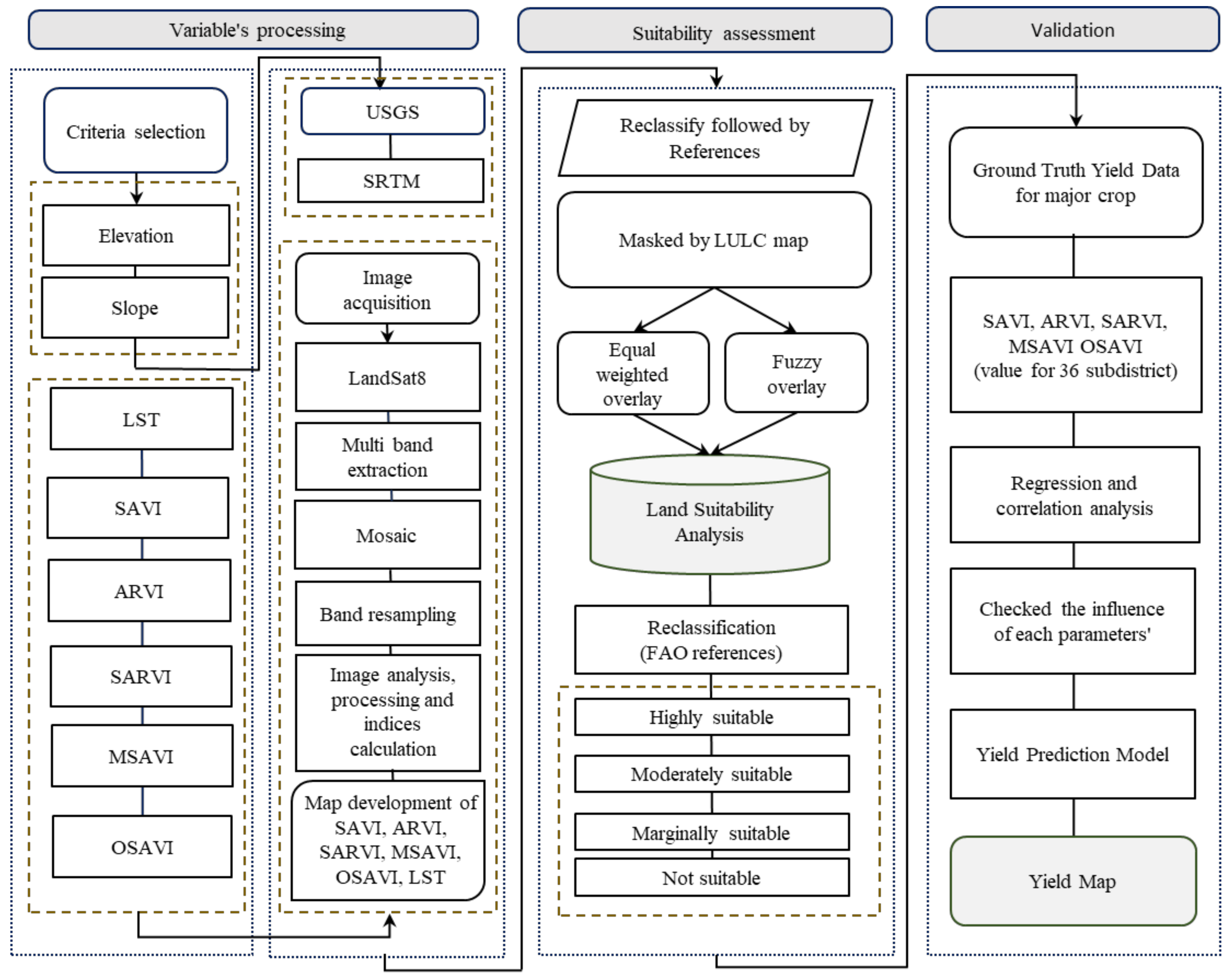

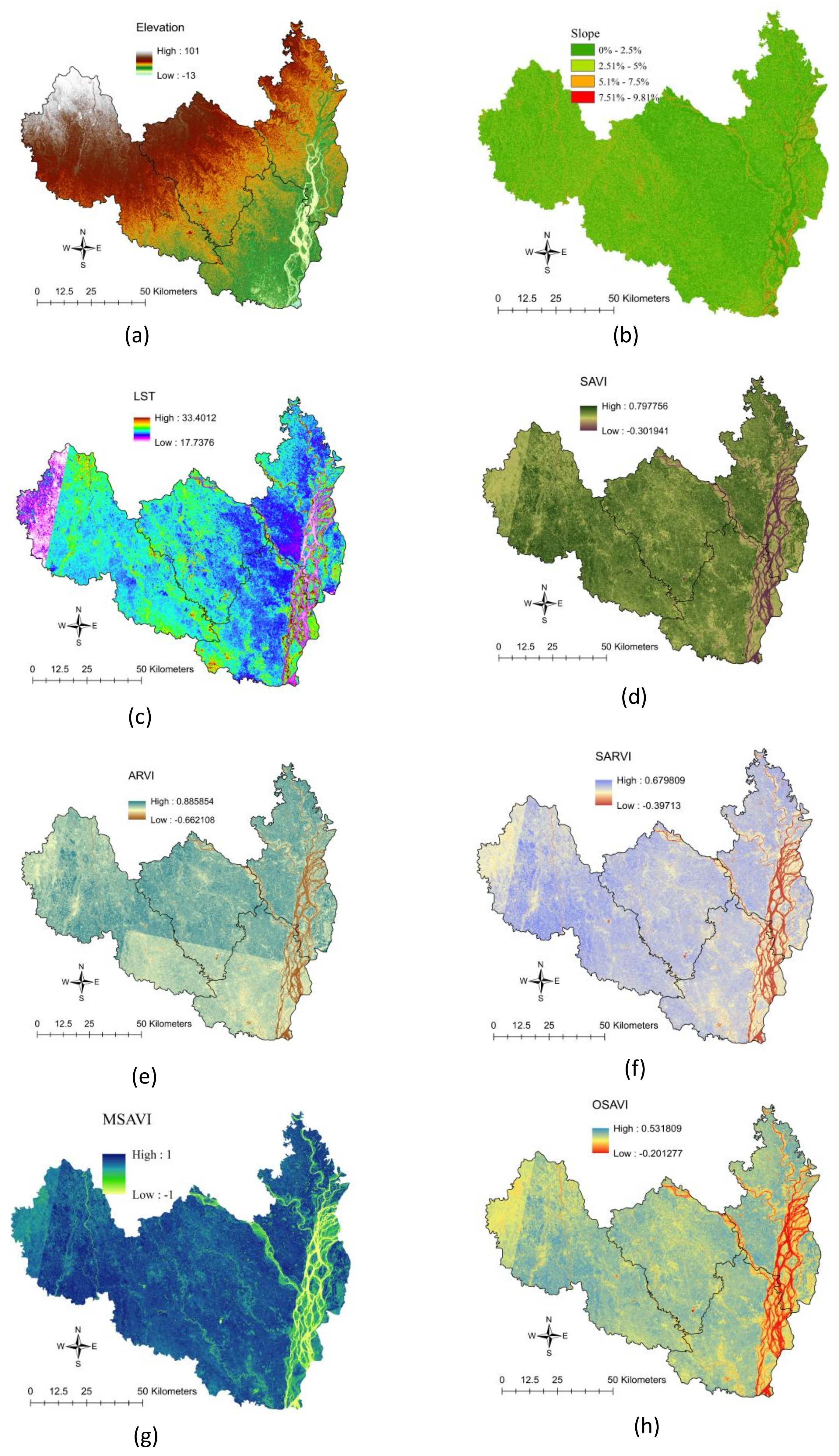

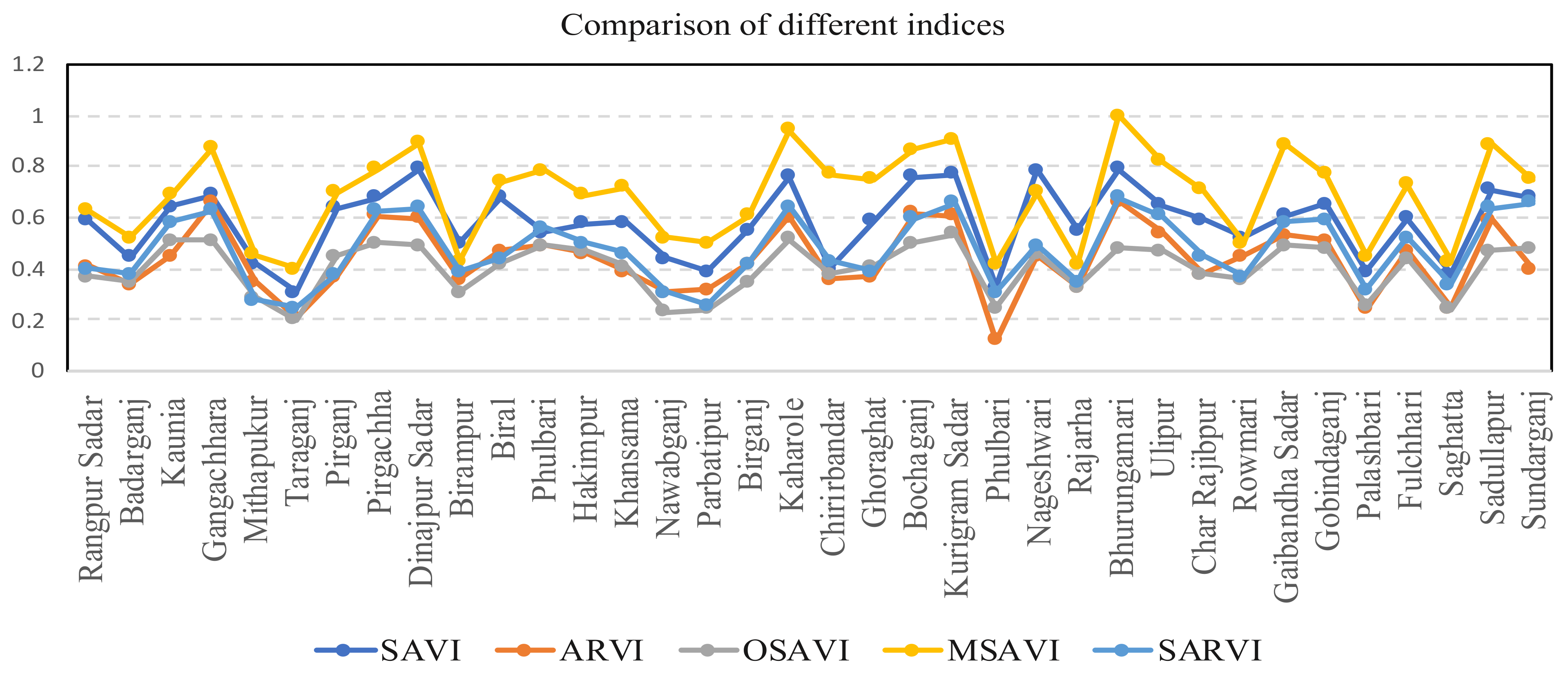
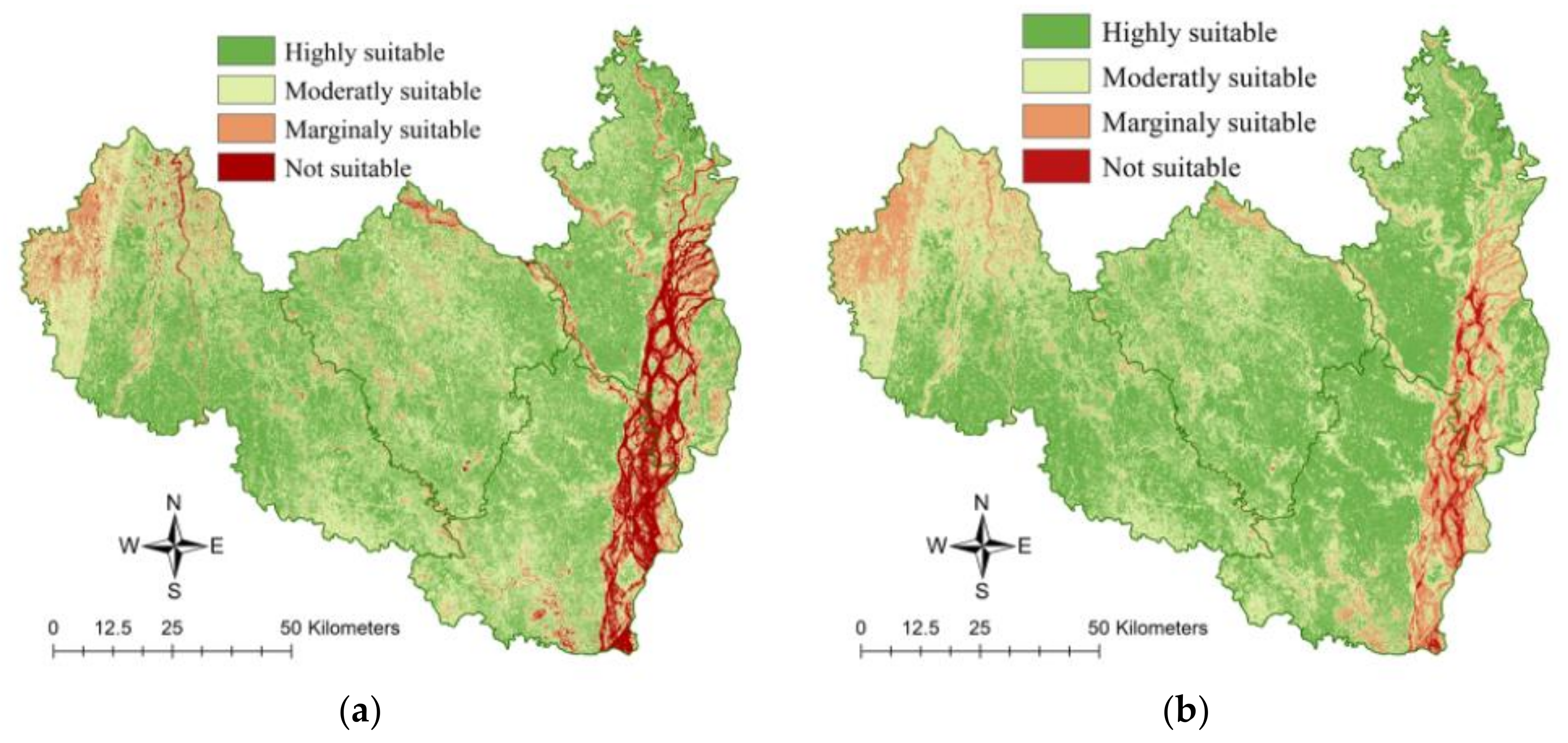

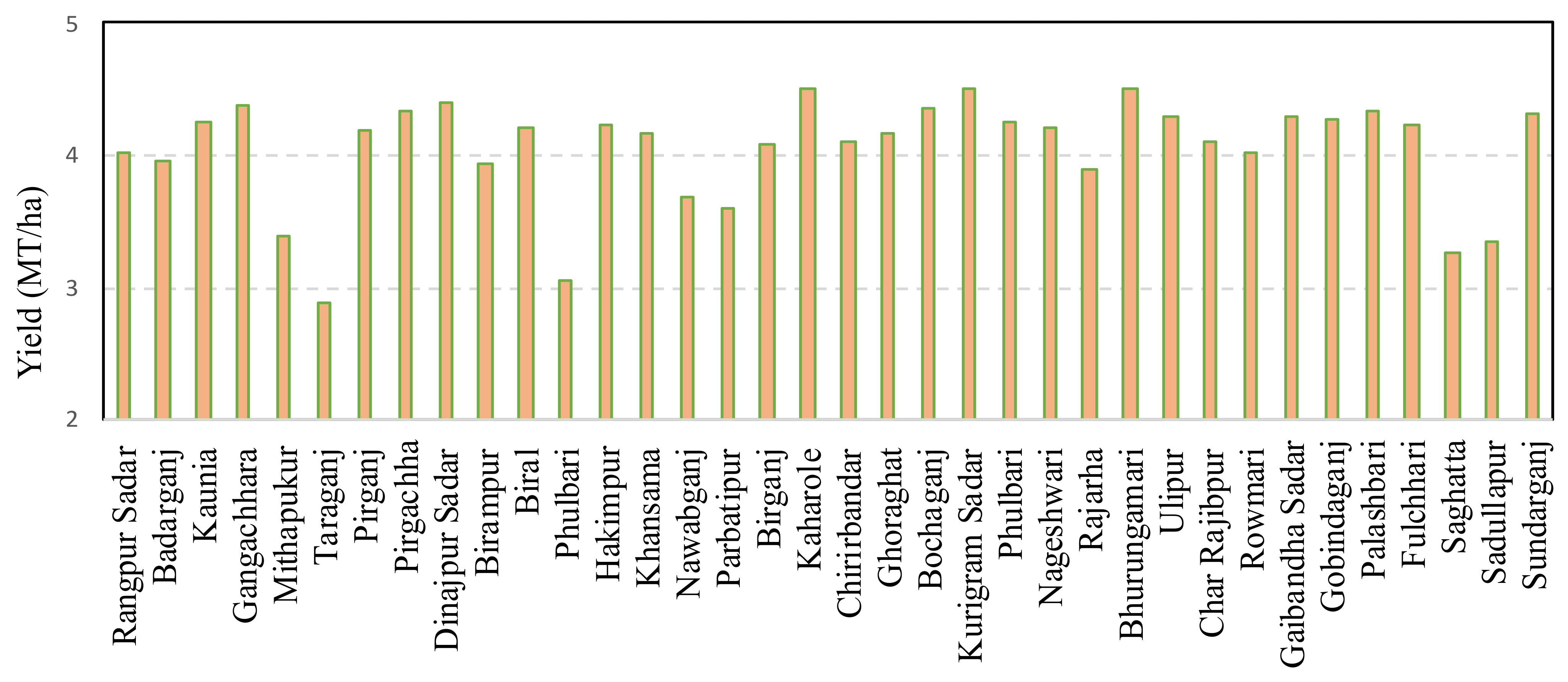
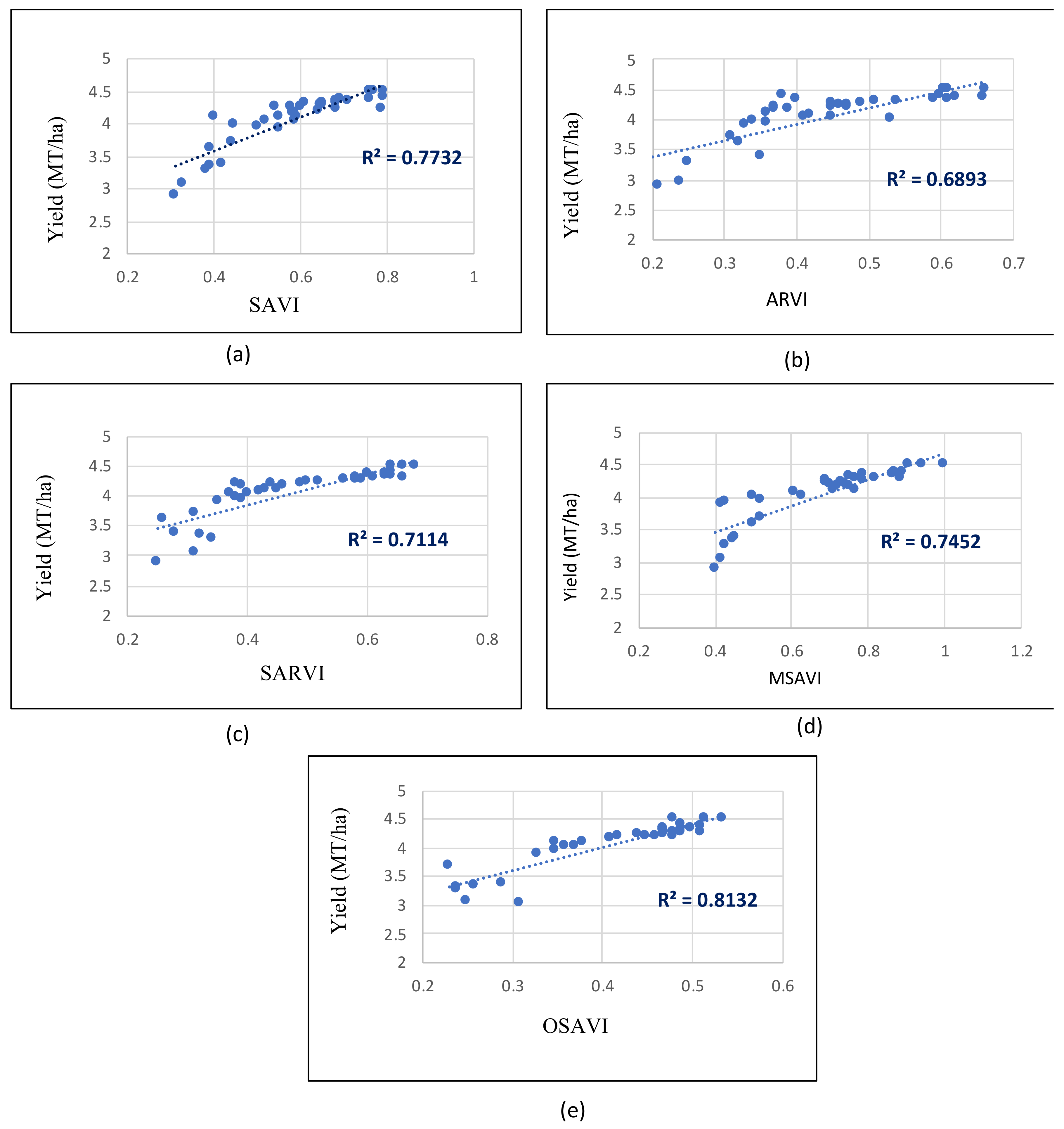
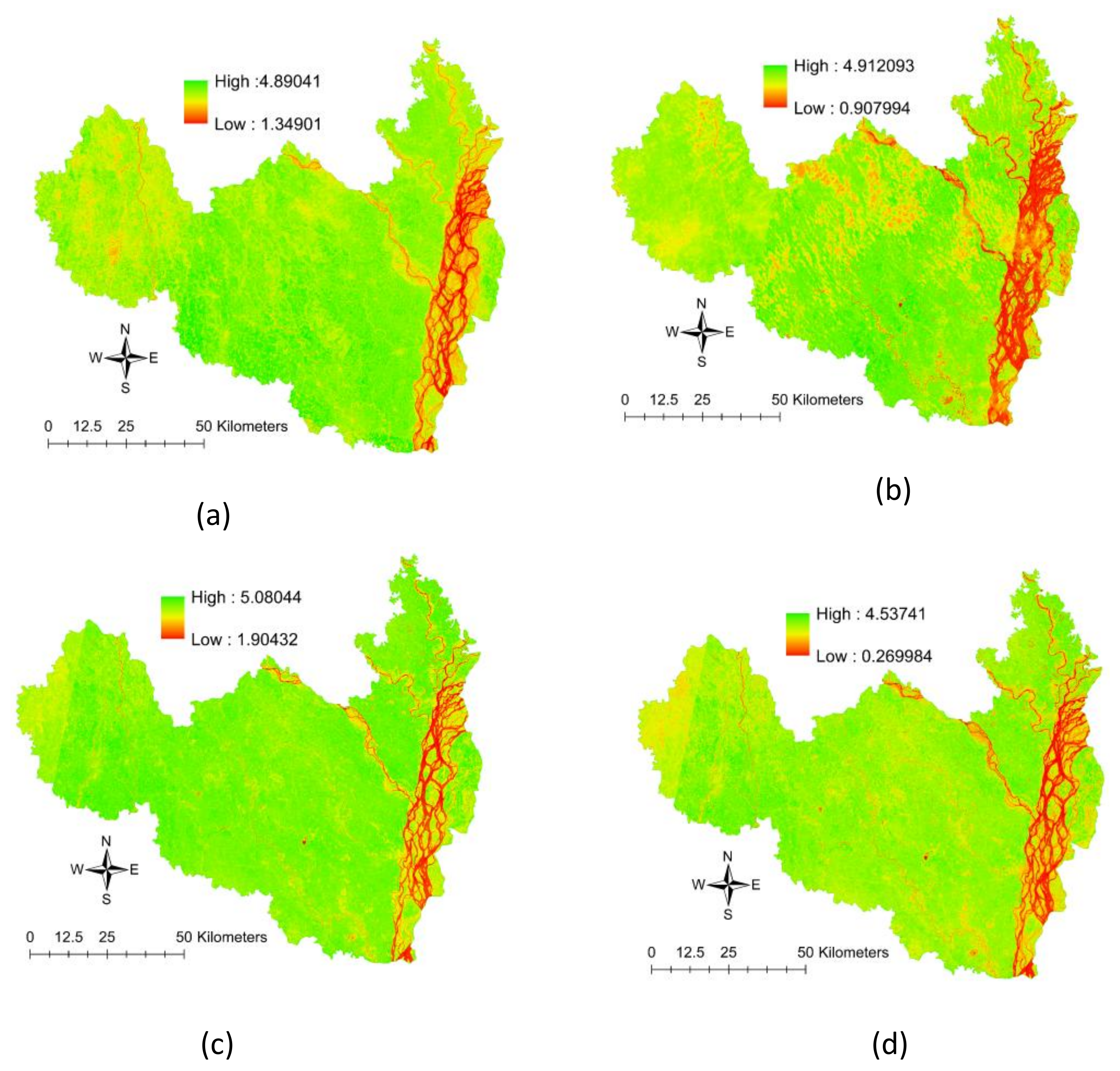
| No | Data | Native Format | Description | Source |
|---|---|---|---|---|
| 1 | Land Use Map | 92 small vector blocks (point, line, polygon, and tabular) | Scale at 1:25,000m | 2019, SoB, Bangladesh |
| 2 | Elevation Map | raster | Extracted from 3 m resolution | 2020, STRM |
| 3 | Slope Map | raster | Derived from 30-mresolution | 2020, STRM |
| 4 | Land Surface Temperature (LST) | raster | Derived from 30-m resolution | 2020, Landsat 8 |
| 5 | SAVI Map | raster | Derived from 30-m resolution | 2020, Landsat 8, USGS |
| 6 | ARVI Map | raster | Derived from 30-m resolution | 2020, Landsat 8, USGS |
| 7 | SARVI Map | raster | Derived from 30-m resolution | 2020, Landsat 8, USGS |
| 8 | MSAVI Map | raster | Derived from 30-m resolution | 2020, Landsat 8, USGS |
| 9 | OSAVI Map | raster | Derived from 30-m resolution | 2020, Landsat 8, USGS |
| Criteria | Suitability Class | Sub Criteria | Reference |
|---|---|---|---|
| S1 | 0–8% | [24,40,41] | |
| Slope | S2 | 8–15% | |
| S3 | 15–25% | ||
| N | >25% | ||
| S1 | 0–25 | [20,42,43] | |
| Elevation | S2 | 25–125 | |
| S3 | 125–250 | ||
| N | >250 | ||
| S1 | 20–25 | [29,44,45] | |
| LST | S2 | 18–20 | |
| S3 | 15–18 | ||
| N | 9–15, >25 | ||
| S1 | 0.372483–0.797756 | [32,46,47] | |
| SAVI | S2 | 0.217838–0.372483 | |
| S3 | 0–0.217838 | ||
| N | −0.301941–0 | ||
| ARVI | S1 | 0.293275–0.885854 | [33,34,48] |
| S2 | 0.1542–0.293275 | ||
| S3 | 0–0.1542 | ||
| N | −0.662108–0 | ||
| S1 | 0.301197–0.671395 | [34,49,50] | |
| SARVI | S2 | 0.301197–0.16658 | |
| S3 | 0.16658–0 | ||
| N | −0.39713–0 | ||
| S1 | 0.752112–1 | [37,46,51] | |
| MSAVI | S2 | 0.752112–0.443157 | |
| S3 | 0.443157–0 | ||
| N | −1–0 | ||
| S1 | 0.245221–0.526082 | [38,46,52] | |
| OSAVI | S2 | 0.145221–0.248311 | |
| S3 | 0–0.145221 | ||
| N | −0.201272–0 |
| Criteria | Most Suitable Condition | Maximum Expectable Condition | Minimum Acceptable Condition | Not Fuzzy Member | Reference | Fuzzy Membership Function |
|---|---|---|---|---|---|---|
| Slope | <4° | 20° | 0° | <20 | [43,56] | F small |
| Elevation | 0 | 0–25 | 250 | >250 | [20,57] | F Gaussian |
| LST | 10 °C–20 °C | up to 35 °C | 10 °C | >35 °C or <20 °C | [45,58] | F Gaussian |
| SAVI | 0.7978 | +1 | −1 | −0.3019 < SAVI < 0.7978 | [11,47,59] | F Linear |
| ARVI | 0.8859 | +1 | −1 | −0.3971 < ARVI < 0.8859 | [33,34,48] | F Linear |
| SARVI | 0.6713 | +1 | −1 | −0.3971< SARVI <0.6713 | [34,49,50] | F Linear |
| MSAVI | 1 | +1 | −1 | −0.1 < MSAVI < 1 | [37,46,51] | F Linear |
| OSAVI | 0.5261 | +1 | −1 | −0.2013< OSAVI <0.5261 | [38,52,60] | F Linear |
| Classification | Suitability Assessment by Equal-Weighted Linear Combination | Suitability Assessment by Fuzzy Membership Function | ||
|---|---|---|---|---|
| Percentage Area (%) | Area (km2) | Percentage Area (%) | Area (km2) | |
| Highly Suitable (S1) | 43 | 1832 | 48 | 2045 |
| Moderately Suitable (S2) | 41 | 1747 | 39 | 1661 |
| Marginally Suitable (S3) | 10 | 426 | 7 | 298 |
| Not Suitable (N) | 6 | 256 | 6 | 256 |
| No | Name | Longitude | Latitude | SAVI | ARVI | SARVI | MSAVI | OSAVI | Yield |
|---|---|---|---|---|---|---|---|---|---|
| 1 | Rangpur Sadar | 89°12′38.681″ E | 25°45′19.004″ N | 0.588 | 0.41 | 0.37 | 0.63 | 0.40 | 4.03 |
| 2 | Badarganj | 89°3′3.041″ E | 25°40′31.185″ N | 0.445 | 0.34 | 0.35 | 0.52 | 0.38 | 3.96 |
| 3 | Kaunia | 89°23′36.554″ E | 25°46′41.239″ N | 0.644 | 0.45 | 0.51 | 0.69 | 0.58 | 4.26 |
| 4 | Gangachhara | 89°12′52.386″ E | 25°51′42.764″ N | 0.69 | 0.66 | 0.51 | 0.87 | 0.63 | 4.37 |
| 5 | Mithapukur | 89°15′9.443″ E | 25°35′2.248″ N | 0.42 | 0.35 | 0.29 | 0.45 | 0.28 | 3.38 |
| 6 | Taraganj | 89°1′54.513″ E | 25°46′54.944″ N | 0.31 | 0.21 | 0.20 | 0.40 | 0.25 | 2.89 |
| 7 | Pirganj | 89°16′17.972″ E | 25°25′40.315″ N | 0.64 | 0.37 | 0.45 | 0.701 | 0.38 | 4.19 |
| 8 | Pirgachha | 89°24′58.788″ E | 25°40′31.185″ N | 0.681 | 0.61 | 0.50 | 0.79 | 0.63 | 4.34 |
| 9 | Dinajpur Sadar | 88°40′39.883″ E | 25°36′38.188″ N | 0.79 | 0.60 | 0.49 | 0.89 | 0.64 | 4.40 |
| 10 | Birampur | 88°58′15.222″ E | 25°22′55.846″ N | 0.50 | 0.36 | 0.31 | 0.43 | 0.39 | 3.94 |
| 11 | Biral | 88°32′53.89″ E | 25°38′55.245″ N | 0.68 | 0.47 | 0.42 | 0.74 | 0.44 | 4.20 |
| 12 | Phulbari | 88°53′27.402″ E | 25°27′2.549″ N | 0.54 | 0.49 | 0.49 | 0.78 | 0.56 | 4.25 |
| 13 | Hakimpur | 89°2′49.336″ E | 25°17′13.204″ N | 0.579 | 0.46 | 0.47 | 0.69 | 0.50 | 4.23 |
| 14 | Khansama | 88°45′55.114″ E | 25°52′51.292″ N | 0.58 | 0.39 | 0.41 | 0.72 | 0.46 | 4.16 |
| 15 | Nawabganj | 89°5′33.804″ E | 25°25′12.903″ N | 0.44 | 0.31 | 0.23 | 0.52 | 0.31 | 3.69 |
| 16 | Parbatipur | 88°55′44.459″ E | 25°37′19.305″ N | 0.39 | 0.32 | 0.24 | 0.50 | 0.26 | 3.60 |
| 17 | Birganj | 88°37′28.004″ E | 25°56′3.172″ N | 0.55 | 0.42 | 0.35 | 0.61 | 0.42 | 4.08 |
| 18 | Kaharole | 88°35′38.358″ E | 25°48′17.178″ N | 0.76 | 0.60 | 0.51 | 0.94 | 0.64 | 4.50 |
| 19 | Chirirbandar | 88°47′3.643″ E | 25°40′31.185″ N | 0.40 | 0.36 | 0.38 | 0.77 | 0.43 | 4.10 |
| 20 | Ghoraghat | 89°12′52.386″ E | 25°17′26.91″ N | 0.59 | 0.37 | 0.41 | 0.75 | 0.39 | 4.16 |
| 21 | Bochaganj | 88°26′43.836″ E | 25°47′22.356″ N | 0.761 | 0.62 | 0.50 | 0.86 | 0.60 | 4.35 |
| 22 | Kurigram Sadar | 89°41′39.304″ E | 25°49′39.413″ N | 0.77 | 0.61 | 0.54 | 0.91 | 0.66 | 4.50 |
| 23 | Phulbari | 88°53′27.402″ E | 25°27′2.549″ N | 0.33 | 0.12 | 0.25 | 0.42 | 0.31 | 3.06 |
| 24 | Nageshwari | 89°44′37.478″ E | 25°58′6.523″ N | 0.79 | 0.45 | 0.46 | 0.70 | 0.49 | 4.20 |
| 25 | Rajarha | 89°32′44.782″ E | 25°47′8.65″ N | 0.55 | 0.33 | 0.33 | 0.42 | 0.35 | 3.90 |
| 26 | Bhurungamari | 89°41′39.304″ E | 26°7′1.045″ N | 0.79 | 0.66 | 0.48 | 0.99 | 0.67 | 4.50 |
| 27 | Ulipur | 89°40′3.364″ E | 25°40′58.596″ N | 0.65 | 0.54 | 0.47 | 0.82 | 0.61 | 4.30 |
| 28 | Char Rajibpur | 89°45′4.889″ E | 25°30′55.546″ N | 0.59 | 0.38 | 0.38 | 0.71 | 0.45 | 4.10 |
| 29 | Rowmari | 89°49′11.592″ E | 25°33′53.72″ N | 0.52 | 0.45 | 0.36 | 0.50 | 0.37 | 4.02 |
| 30 | Gaibandha Sadar | 89°34′48.133″ E | 25°57′11.701″ N | 0.61 | 0.53 | 0.49 | 0.88 | 0.58 | 4.30 |
| 31 | Gobindaganj | 89°22′0.614″ E | 25°10′8.327″ N | 0.65 | 0.51 | 0.48 | 0.77 | 0.59 | 4.28 |
| 32 | Palashbari | 89°23′22.848″ E | 25°16′18.381″ N | 0.39 | 0.24 | 0.26 | 0.45 | 0.32 | 4.34 |
| 33 | Fulchhari | 89°39′35.953″ E | 25°15′37.264″ N | 0.60 | 0.47 | 0.44 | 0.73 | 0.52 | 4.24 |
| 34 | Saghatta | 89°34′34.427″ E | 25°7′37.565″ N | 0.38 | 0.25 | 0.24 | 0.43 | 0.34 | 3.27 |
| 35 | Sadullapur | 89°25′12.494″ E | 25°24′4.375″ N | 0.71 | 0.59 | 0.47 | 0.88 | 0.64 | 3.34 |
| 36 | Sundarganj | 89°33′39.605″ E | 25°30′28.134″ N | 0.68 | 0.4 | 0.48 | 0.75 | 0.66 | 4.31 |
| Forecasting Factors | R2 | Simple Regression |
|---|---|---|
| SAVI | 0.773 | Y = 2.6021 * SAVI + 2.5319 |
| ARVI | 0.689 | Y = 2.726 * ARVI + 2.8479 |
| SARVI | 0.711 | Y = 2.5832 * SARVI + 2.8184 |
| MSAVI | 0.7452 | Y = 2.024 * MSAVI + 2.6627 |
| OSAVI | 0.812 | Y = 4.0094 * OSAVI + 2.4039 |
| All Combination | 0.839 | Y = 0.534 * SAVI + 0.226 * ARVI − 0.907 * SARVI + 0.0922 * MSAVI + 3.264 * OSAVI |
Publisher’s Note: MDPI stays neutral with regard to jurisdictional claims in published maps and institutional affiliations. |
© 2021 by the authors. Licensee MDPI, Basel, Switzerland. This article is an open access article distributed under the terms and conditions of the Creative Commons Attribution (CC BY) license (http://creativecommons.org/licenses/by/4.0/).
Share and Cite
Binte Mostafiz, R.; Noguchi, R.; Ahamed, T. Agricultural Land Suitability Assessment Using Satellite Remote Sensing-Derived Soil-Vegetation Indices. Land 2021, 10, 223. https://doi.org/10.3390/land10020223
Binte Mostafiz R, Noguchi R, Ahamed T. Agricultural Land Suitability Assessment Using Satellite Remote Sensing-Derived Soil-Vegetation Indices. Land. 2021; 10(2):223. https://doi.org/10.3390/land10020223
Chicago/Turabian StyleBinte Mostafiz, Rubaiya, Ryozo Noguchi, and Tofael Ahamed. 2021. "Agricultural Land Suitability Assessment Using Satellite Remote Sensing-Derived Soil-Vegetation Indices" Land 10, no. 2: 223. https://doi.org/10.3390/land10020223
APA StyleBinte Mostafiz, R., Noguchi, R., & Ahamed, T. (2021). Agricultural Land Suitability Assessment Using Satellite Remote Sensing-Derived Soil-Vegetation Indices. Land, 10(2), 223. https://doi.org/10.3390/land10020223







